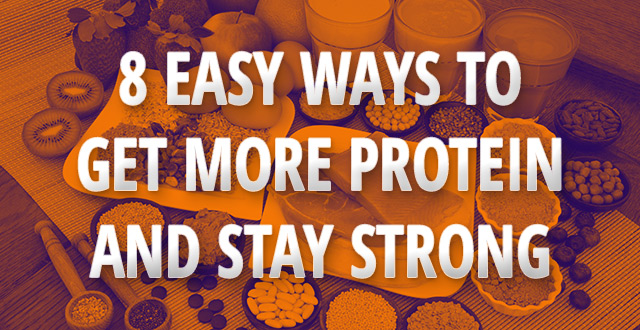As rates of cardiovascular disease, metabolic syndrome and diabetes continue to rise in all populations, including those over 65, it is important to keep a healthy and balanced diet. More than ever it is imperative to get all of your essential amino acids from balanced proteins to keep your mind and body strong. But believe it or not, you don’t have to load up on fatty or chewy meats to meet your protein needs every day. There are several healthy vegan and non-vegan sources of protein right at your finger tips.
Here are 8 really easy ways to get more protein and stay strong and healthy!
1. Protein Powders
Protein powders are easy and portable ways to get in that extra protein boost. If you’re starting a new workout regimen and need the muscle building power, or just want to punch up your smoothies, soups, puddings or desserts, there are several pleasant tasting powders to choose from.
Hemp and pea protein powders are my top vegan options for protein supplements. Rice protein is also a top contender. Peanut protein may cause severe allergic reactions in some, while soy isolate contains high levels of phyto-estrogens (plant hormones) and can interfere with human hormone levels. Whey powder is the most popular protein supplement and can be found in almost every supermarket shelf in America. It does come from dairy milk, so it’s not vegan. And if it’s inorganic it will usually contain higher levels of rBST (bovine growth hormone) and traces of pesticides used in the feed.
Seems hard to believe but many plants actually contain decent protein levels per volume, calories or carbohydrates. Here are some lists you might find useful (generally highest to lowest):
2. High Protein Veggies
- Spinach
- Kale
- Broccoli
- Broccoli rabe (rapini)
- Cauliflower
- Collard greens
- Mustard greens
- Beet greens
- Bean, pea and lentil sprouts
- Arugula
- Parsley
- Watercress and garden cress
- Bamboo shoots
- Mushrooms
- Brussel sprouts
- Artichokes
- Asparagus
- Baby zucchini
- Bok choy (Chinese cabbage)
- Squash
3. High Protein Peas and Beans
- Lupin Beans
- Soybeans
- Lentils
- Winged Beans
- Split Peas
- Great Northern Beans
- Yardlong Beans
- White Beans
- Fava Beans (broad beans)
- Kidney Beans
- Black Beans
- Mung Beans
- Cowpeas (black-eyed peas)
- Yellow Beans
- Pinto Beans
- Pink Beans
- Navy Beans (baked beans)
- Pigeon Peas
- Green Beans
- Chickpeas (garbanzo beans)
- Lima Beans
- Pod Peas (sugar snap and snow peas)
4. High Protein Grains
Cooked:
- Oat bran
- Soba noodles
- Oatmeal (porridge)
- Spelt
- Kamut (khorasan)
- Amaranth
- Whole wheat pasta
- Teff
- Wild rice
- Buckwheat groats
- Bulgur wheat
- Couscous
- Millet
- Brown rice
- Pearled barley
- Rice noodles
- Corn kernels
Uncooked:
- Wheat germ
- Rice bran
- Oats
- Wheat bran
- Semolina
- Rye grain
- Yellow or white corn grain
5. Other High Protein Foods
Soy-based foods like tofu, tempeh, natto and soymilk have similar benefits and drawbacks to their wholefood cousin, the soybean. Chia, flax, and hemp seeds or meal are also nice additions to smoothies, juices, soups and puddings. Quinoa is gluten-free, cooks up like couscous or bulgar wheat, and has the highest protein content of any “grain.” It’s actually a relative of beets and spinach, and is not technically a grain because it’s not in the grass family.
Unsweetened chocolate and cacao powder (unsweetened raw cocoa) make great protein rich additions to both sweet and savory dishes. Hummus, falafel, peanuts and peanut butter also make tasty protein packed snacks.
6. Nuts for Protein
Pumpkin seeds (pepitas), almonds, walnuts, pistachios and cashews pack the best protein punch for their fat content. Brazil nuts, pecans and macadamia nuts are delicious but higher in fat and lower in protein.
7. Protein from Fruit
Your best bet for getting your protein from these sweet sources means sticking to guavas, mulberries, blackberries, starfruit, apricots, kumquats, white grapefruit, nectarines, cantaloupe and peaches. The protein to calorie and sugar ratio in raspberries, passion fruit, strawberries, oranges, watermelon, cherries, honeydew and bananas is a little low, but worth mentioning. And avocados are just delicious and full of healthy fats, so eat them regardless!
8. Meat and Dairy Protein
Of course organic meats, eggs and dairy products are the traditional non-vegan way to get your protein. Make sure you get plenty of extra calcium and vitamin D with your organic Greek yogurt, low-fat cottage cheese, hard cheeses and nonfat dairy milk. Because the higher the protein in dairy the more your body actually leeches calcium from your bones to turn the acidic intestinal environment neutral. Meaning dairy can potentially increase instead of decrease the risk of osteoporosis. (How about that!) And keep those lean cuts of organic chicken and turkey, and grass-fed lamb and beef to about 4 oz per portion; the size of a deck of cards.
With all these tips, excellent sources of protein will be easy to come by. And you’ll be on your way to a stronger, healthier you in no time.

